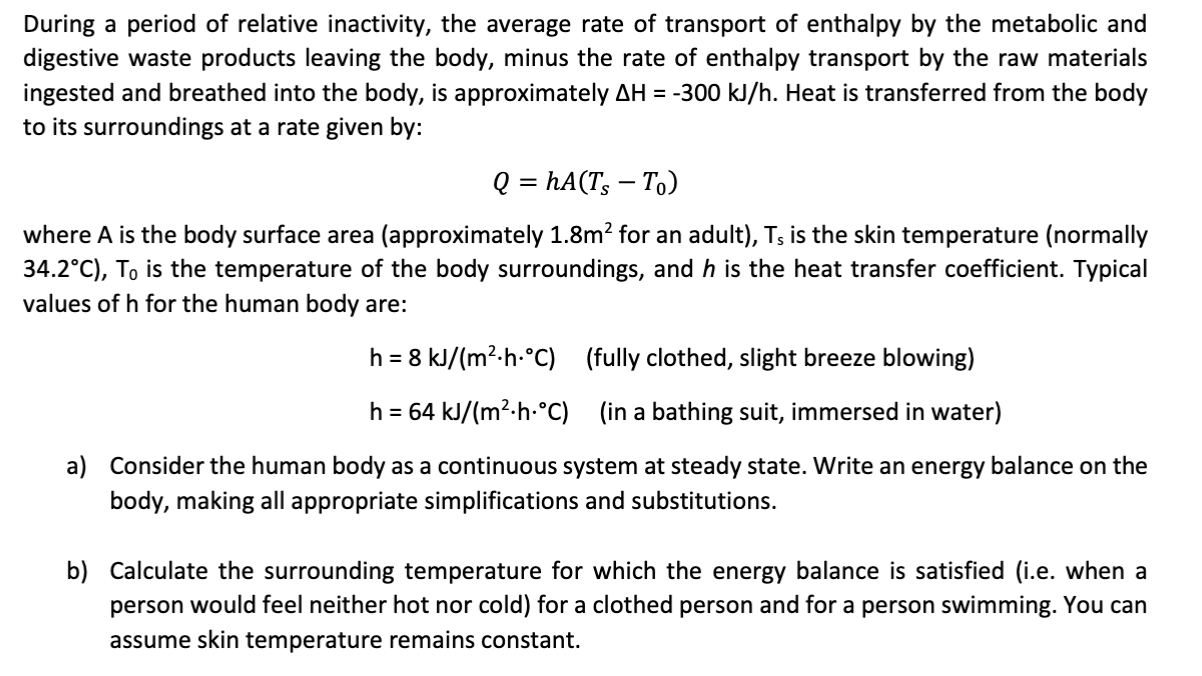During a period of relative inactivity, the average rate of transport of enthalpy by the metabolic and digestive waste products leaving the body, minus the rate of enthalpy transport by the raw materials ingested and breathed into the body, is approximately AH -300 kJ/h. Heat is transferred from the body to its surroundings at a rate given by: Q = hA(T To) where A is the body surface area (approximately 1.8m2 for an adult), Ts is the skin temperature (normally 34.2°C), To is the temperature of the body surroundings, and h is the heat transfer coefficient. Typical values of h for the human body are: (fully clothed, slight breeze blowing) h 8 kJ/(m2-h-°C) = h 64 kJ/(m2-h-°C) (in a bathing suit, immersed in water) a) Consider the human body as a continuous system at steady state. Write an energy balance on the body, making all appropriate simplifications and substitutions. b) Calculate the surrounding temperature for which the energy balance is satisfied (i.e. when a cold) for a clothed person and for a person swimming. You can person would feel neither hot nor assume skin temperature remains constant
During a period of relative inactivity, the average rate of transport of enthalpy by the metabolic and digestive waste products leaving the body, minus the rate of enthalpy transport by the raw materials ingested and breathed into the body, is approximately AH -300 kJ/h. Heat is transferred from the body to its surroundings at a rate given by: Q = hA(T To) where A is the body surface area (approximately 1.8m2 for an adult), Ts is the skin temperature (normally 34.2°C), To is the temperature of the body surroundings, and h is the heat transfer coefficient. Typical values of h for the human body are: (fully clothed, slight breeze blowing) h 8 kJ/(m2-h-°C) = h 64 kJ/(m2-h-°C) (in a bathing suit, immersed in water) a) Consider the human body as a continuous system at steady state. Write an energy balance on the body, making all appropriate simplifications and substitutions. b) Calculate the surrounding temperature for which the energy balance is satisfied (i.e. when a cold) for a clothed person and for a person swimming. You can person would feel neither hot nor assume skin temperature remains constant
Introduction to Chemical Engineering Thermodynamics
8th Edition
ISBN:9781259696527
Author:J.M. Smith Termodinamica en ingenieria quimica, Hendrick C Van Ness, Michael Abbott, Mark Swihart
Publisher:J.M. Smith Termodinamica en ingenieria quimica, Hendrick C Van Ness, Michael Abbott, Mark Swihart
Chapter1: Introduction
Section: Chapter Questions
Problem 1.1P
Related questions
Question

Transcribed Image Text:During a period of relative inactivity, the average rate of transport of enthalpy by the metabolic and
digestive waste products leaving the body, minus the rate of enthalpy transport by the raw materials
ingested and breathed into the body, is approximately AH -300 kJ/h. Heat is transferred from the body
to its surroundings at a rate given by:
Q = hA(T To)
where A is the body surface area (approximately 1.8m2 for an adult), Ts is the skin temperature (normally
34.2°C), To is the temperature of the body surroundings, and h is the heat transfer coefficient. Typical
values of h for the human body are:
(fully clothed, slight breeze blowing)
h 8 kJ/(m2-h-°C)
=
h 64 kJ/(m2-h-°C)
(in a bathing suit, immersed in water)
a)
Consider the human body as a continuous system at steady state. Write an energy balance on the
body, making all appropriate simplifications and substitutions.
b) Calculate the surrounding temperature for which the energy balance is satisfied (i.e. when a
cold) for a clothed person and for a person swimming. You can
person would feel neither hot nor
assume skin temperature remains constant
Expert Solution
This question has been solved!
Explore an expertly crafted, step-by-step solution for a thorough understanding of key concepts.
This is a popular solution!
Trending now
This is a popular solution!
Step by step
Solved in 4 steps with 3 images

Recommended textbooks for you

Introduction to Chemical Engineering Thermodynami…
Chemical Engineering
ISBN:
9781259696527
Author:
J.M. Smith Termodinamica en ingenieria quimica, Hendrick C Van Ness, Michael Abbott, Mark Swihart
Publisher:
McGraw-Hill Education

Elementary Principles of Chemical Processes, Bind…
Chemical Engineering
ISBN:
9781118431221
Author:
Richard M. Felder, Ronald W. Rousseau, Lisa G. Bullard
Publisher:
WILEY

Elements of Chemical Reaction Engineering (5th Ed…
Chemical Engineering
ISBN:
9780133887518
Author:
H. Scott Fogler
Publisher:
Prentice Hall

Introduction to Chemical Engineering Thermodynami…
Chemical Engineering
ISBN:
9781259696527
Author:
J.M. Smith Termodinamica en ingenieria quimica, Hendrick C Van Ness, Michael Abbott, Mark Swihart
Publisher:
McGraw-Hill Education

Elementary Principles of Chemical Processes, Bind…
Chemical Engineering
ISBN:
9781118431221
Author:
Richard M. Felder, Ronald W. Rousseau, Lisa G. Bullard
Publisher:
WILEY

Elements of Chemical Reaction Engineering (5th Ed…
Chemical Engineering
ISBN:
9780133887518
Author:
H. Scott Fogler
Publisher:
Prentice Hall


Industrial Plastics: Theory and Applications
Chemical Engineering
ISBN:
9781285061238
Author:
Lokensgard, Erik
Publisher:
Delmar Cengage Learning

Unit Operations of Chemical Engineering
Chemical Engineering
ISBN:
9780072848236
Author:
Warren McCabe, Julian C. Smith, Peter Harriott
Publisher:
McGraw-Hill Companies, The